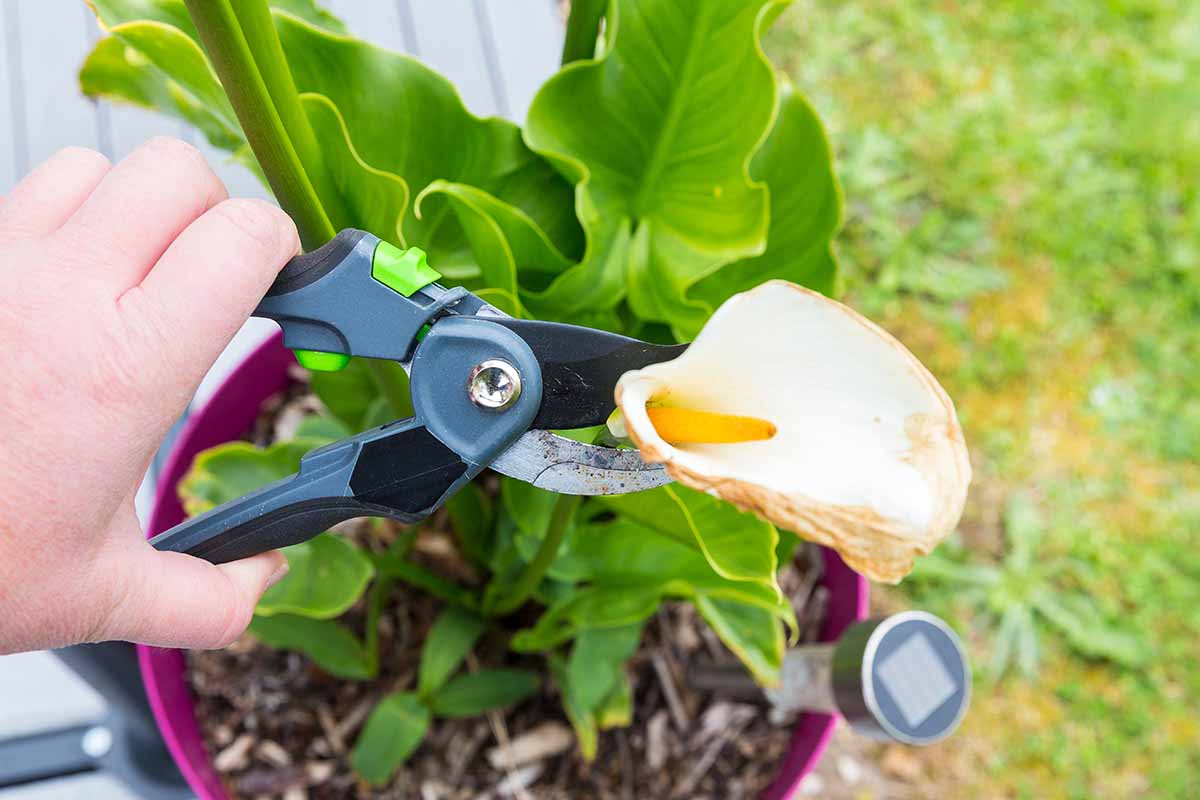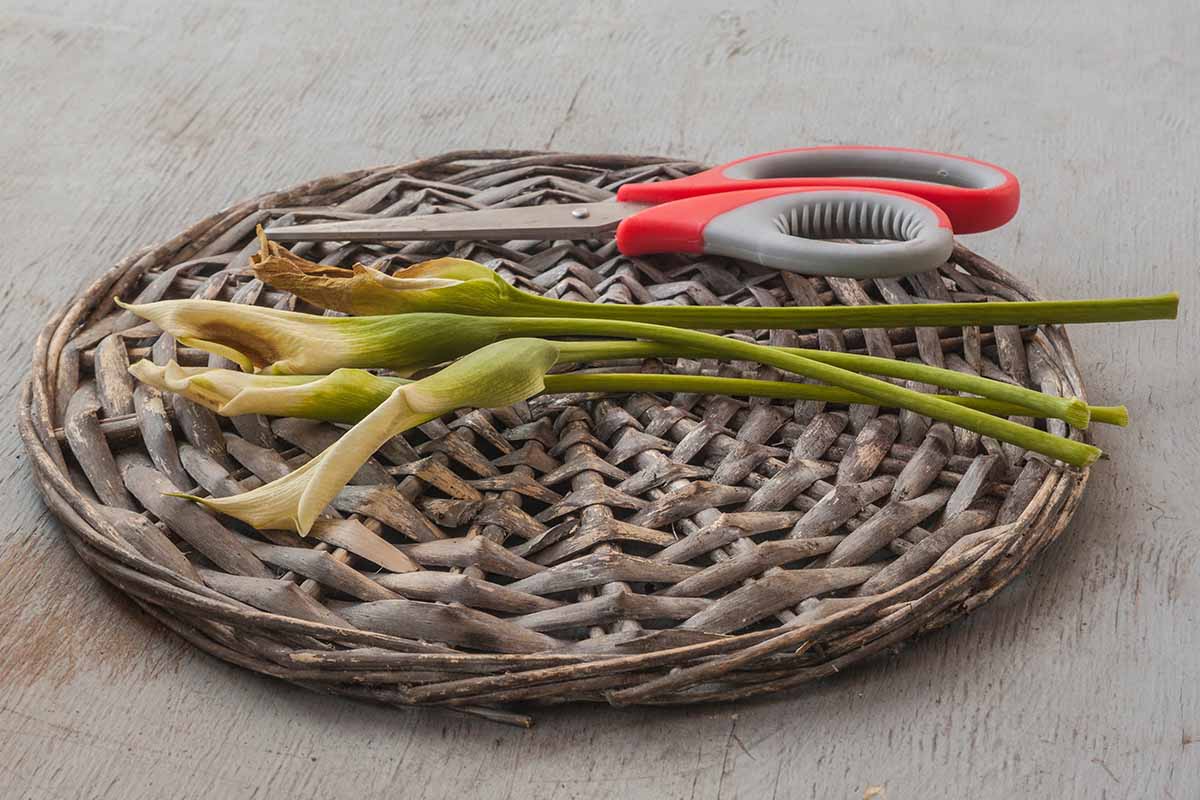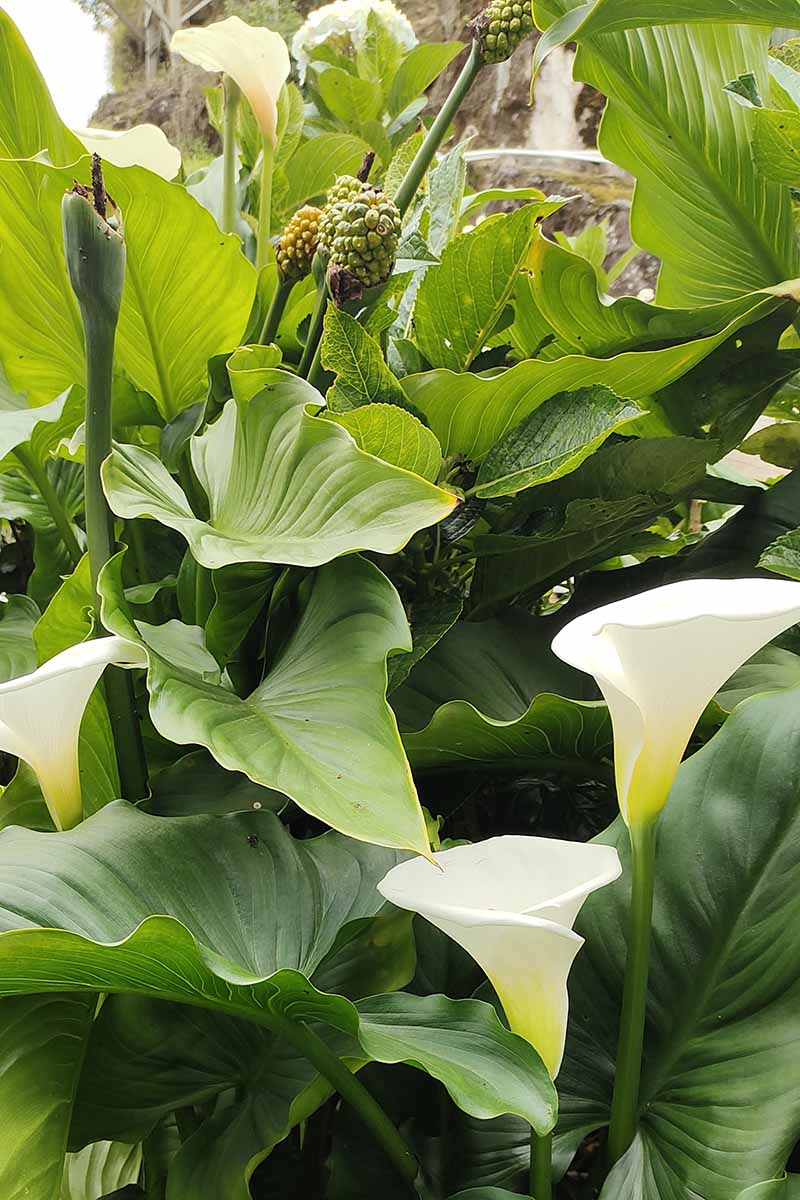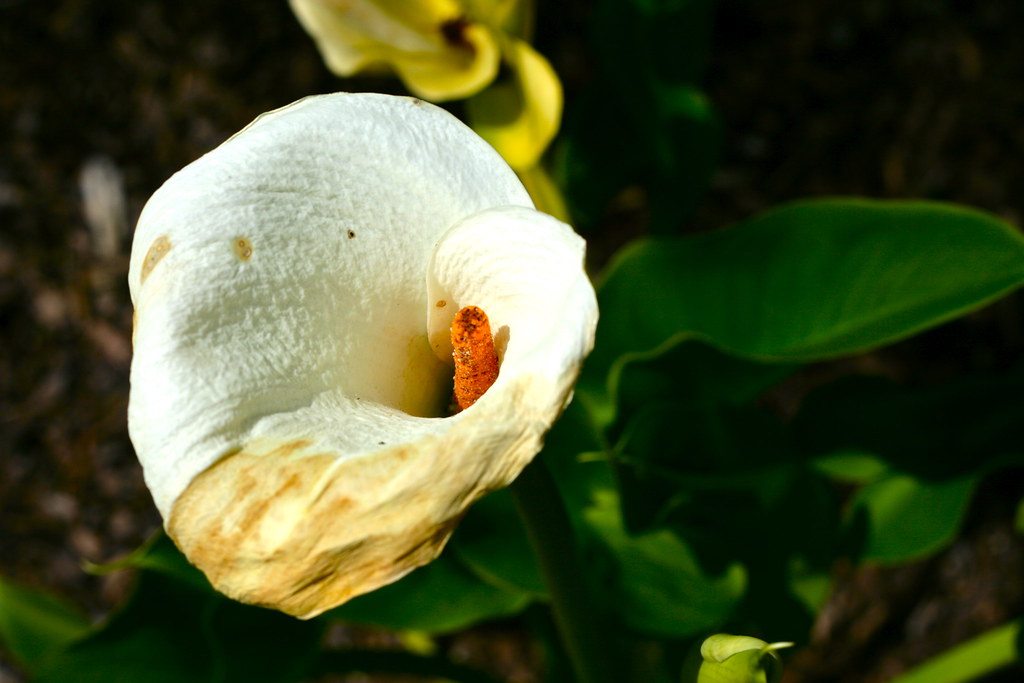Calla lilies, Zantedeschia spp., are flowering rhizomes suited to year-round cultivation in USDA Hardiness Zones 8 to 11.
In cooler places, they are grown as annuals, and when the season is over, they are lifted and stored until the next spring.
We link to vendors to help you find relevant products. If you buy from one of our links, we may earn a commission.
There are evergreen and semi-evergreen arum lilies, as well as hybrids that lose their leaves in the fall. The flowers have a funnel-shaped, petal-like spathe that swirls around a central spike called a spadix.
Our growing calla lilies guide has everything you need to know about taking care of plants outside.
Calla lilies are stunning flowers that add elegance and visual interest to any garden. Their unique shape and range of colors, from white to pink, yellow, and more, make them popular in cut flower arrangements as well. But when those blooms start to fade, what should you do? Do you need to deadhead calla lilies?
The simple answer is yes, you should deadhead spent calla blossoms But why, and how exactly should you do it? Keep reading for a complete guide to deadheading calla lilies
Why Deadhead Calla Lilies?
Deadheading is the process of removing spent flowers from a plant by pinching or cutting them off. Most people deadhead flowers for aesthetic reasons – expired blooms look unsightly and detract from the beauty of the plant.
With calla lilies, there are other reasons to practice deadheading as well:
-
Improves plant health: Once pollinated, calla flowers will often form seed pods. This takes energy away from bulb growth. Removing spent blooms prevents seed pod formation, allowing the plant to focus its resources on storing energy in the underground rhizomes. This results in stronger, healthier plants the following year.
-
Encourages reblooming While deadheading doesn’t make calla lilies produce more flowers in the current season, it can help stimulate reblooming the next year by directing more energy into rhizome growth rather than seed production.
-
Enhances visual appeal: Deadheaded calla plants simply look more attractive and tidy. The foliage remains fresh and vibrant without drooping, brown flowers detracting from the look.
When to Deadhead Callas
Calla lilies only bloom once per year, so deadheading really only needs to be done after the initial flowering. There are two ways to identify spent blooms that are ready for deadheading:
-
Fading/browning petals: Look for flowers where the petals have withered, faded in color, or turned brown. These blooms are clearly expired and can be removed.
-
Rolled up petals: Spent calla flowers often tightly roll into a tubular shape rather than just wilting. For blooms in this condition, deadheading is recommended even if the petal color still looks vibrant.
In either case, deadhead calla blossoms as soon as you notice signs they are past their prime. Don’t wait for them to get overly dry and brown. Timely deadheading keeps plants looking their best.
How to Deadhead Calla Lilies
Deadheading calla lilies is a quick and simple process. Here are the steps:
-
Use a pair of sharp, clean pruners or scissors. Sterilize the blades first with isopropyl alcohol to prevent transmitting diseases between plants.
-
Locate the spent bloom on the tall stalk. Position the blades of your clippers just below the flower itself at an angle.
-
Make one clean snip to remove the flower. Leave as much of the stem intact as possible – cut near the base of the bloom but not all the way down to the ground.
-
Drop the trimmed off bloom into your yard waste bin. Do not compost diseased flowers.
-
Optionally, trim off the remaining bare stem back down to the calla foliage. This leaves plants looking tidier. But leave at least 2-3 inches to avoid damaging the rhizomes.
-
Wash and sterilize your pruners before deadheading another calla or moving onto other plants. Proper sanitation prevents disease spread.
That’s all there is to it! Deadhead faded calla blossoms as needed throughout their bloom period to keep your plants looking pristine.
Deadheading Calla Lily Pots and Cut Flowers
Calla lilies grown in containers and those cut for flower arrangements require deadheading too. Follow the same steps:
-
For container callas, simply pinch or snip off the droopy, faded flowers. Leave short stem stubs.
-
For cut calla stems, recut the bottoms by a few inches after blooms expire. This provides fresh xylem tissue to take up water, prolonging vase life. Change the water as well.
Proper deadheading keeps potted and cut calla lilies looking their best for longer.
Deadheading Calla Lily Seed Pods
If you want to collect calla seeds, leave spent blooms in place until the seed pods mature. They appear as green teardrop-shaped pods behind shriveled brown flowers. Once the pods turn yellowish and split open, seeds can be gathered.
After collecting seeds, prune the pods off the plants. Callas look far better without old drying seed heads hanging around.
However, collecting calla seeds is difficult and germination rates are low. Most gardeners are better off deadheading fully spent flowers before seed pods form. This directs energy into the rhizomes for better growth and flowering next year.
Deadleaf Removal
In addition to deadheading flowers, it’s also important to prune off aging calla lily leaves periodically. Remove yellowed, shriveled foliage and any leaves damaged by pests or disease.
This keeps plants looking fresh. It also reduces the spread of problems like fungal diseases. Focus on pulling off outer, lower leaves and leaving newer central growth intact.
Avoiding Common Mistakes
Deadheading mistakes to steer clear of when caring for calla lilies include:
-
Leaving dried up flowers in place – this looks unsightly.
-
Cutting stems too short – leave some length to feed the rhizomes.
-
Skipping sterilization of tools – invites disease transmission.
-
Deadheading too early – wait for flowers to fade before removing.
-
Not pruning off dead leaves – foliage cleanup is important too.
With the proper technique and timing, deadheading spent blooms improves calla plant and flower beauty dramatically. Just use care not to damage the tender rhizomes beneath the soil when snipping off flowers.
The Takeaway
To recap, deadheading calla lilies means removing spent flowers once they fade and wither. Doing so directs energy back to the rhizomes for improved growth and flowering in the future. It also simply makes callas look more attractive.
Deadhead callas using sterilized pruners, cutting stems just below faded blooms but leaving some length. Prune off dead leaves periodically as well to maintain a tidy appearance. With proper deadheading technique, your calla lily plants will continue providing enjoyment season after season.
Deadheading to Prevent Seed Setting
Deadheading is an optional garden practice. In the case of calla lilies, it doesn’t quite mean taking off the dead flower heads.

They will be dead when we take off the spathes because the seeds will have set, which means the plant is dead. We don’t want that to happen.
Instead, we want to cut off whole stems of spent flowers before the spathes lose their color and the flowers start to turn into seeds.
By cutting at this time, we redirect the plant’s energy from seed setting to reproductive growth and flowering.
When you cut stems as close to where they started as possible, they grow back faster because all stems start at the basal leaf mound.

If we don’t deadhead, the spathes turn brown and seed-containing pods form at their base.
There are fewer and fewer flowers as more pods form because making and spreading seeds takes most of the plant’s energy.
Some flora is self-deadheading, like petunia varieties that shed spent blooms to make way for new ones.
Some plants, like tulips and daffodils that bloom in the spring, don’t make new flowers after you remove the dead flowers. This is because they can only bloom once during the growing season.
When plants respond to being deadheaded by making more flowers, you can enjoy more flowers and, if the weather permits, a longer growing season.
When deadheading, it’s essential to use sanitary pruners or scissors.

When you cut the plant back, be sure to only remove the spent flower stems and not the nearby leaves. This is because the leaves feed the rhizomes so that they have the energy to grow and bloom again the following year.
You might think it would be better to just cut off the spathes and let the stems feed the rootstock.
The answer is no, and here’s why:
Like many tuberous plants, callas have hollow stems. They could get water inside, which could kill the rhizomes below, if you leave them open at the top.
Another reason for pruning entire stems as we do is because they are leafless. Other plants, like coneflowers, have leafy stems. Since every leaf is a growth point, we cut off the flower stems just above a leaf to encourage new growth and blooming.
You should carefully cut the stems close to the base and down between the leaves to deadhead these plants. This is where they naturally sprout from.
You can read more about deadheading garden flowers in our guide. It’s a great way to encourage many plants to rebloom and keep the landscape looking fresh and tidy.
The Cycle of Life
The lifecycle of the average perennial flower begins with vegetative growth or leaf production.
Once the leaves mature, the reproductive phase begins with budding, which is soon followed by blooming.

Seed formation completes the succession of events and takes place after the petals fade and wither. When the seeds disperse, they ensure the survival of the species.
What would happen if we prevented seed formation? Would there be additional blooming? Let’s find out!
Deadhead Calla Lily – How to Remove Dead Flowers & keep It blooming?
Should you Deadhead a calla lily?
The rule of thumb to deadhead spent calla lily flowers and leaves at the end of the blooming period. Keep watering the plant until its leaves turn brown and crispy to strengthen the rhizomes and make them store more energy for the next season. Dig out outdoor calla lily rhizomes and keep them in a cool, dry space at 50-60°F.
Do calla lilies need care?
Here are some essential care tips for growing healthy calla lilies: 1.**Light**: Calla lilies thrive in **full sun** or **partial shade**.They need ample light for flower production.If you live in a particularly
Should I cut Dead Flowers off my calla lilies?
So you may wonder, “Should I cut dead flowers off my Calla Lily?” You should remove faded and dead flowers from your Calla Lilies because deadheading is beneficial to the plant. But it’s not a requirement for your Lilies’ health and well-being.
What happens when a Calla Lily dies?
Once the calla flower begins to die, it rolls up into a tube, often turning green on the outside. These spent blossoms on calla lily plants are done, have no purpose and should be clipped off. Learn how to deadhead calla lily and the benefits of removing spent blossoms instead of leaving them on the stems.
- The Ultimate Guide to Growing Strawberries in Raised Beds - August 8, 2025
- No-Dig Garden Beds: The Easiest Way to Grow a Beautiful Garden - August 6, 2025
- How to Protect and Preserve Wood for Raised Garden Beds - August 6, 2025

